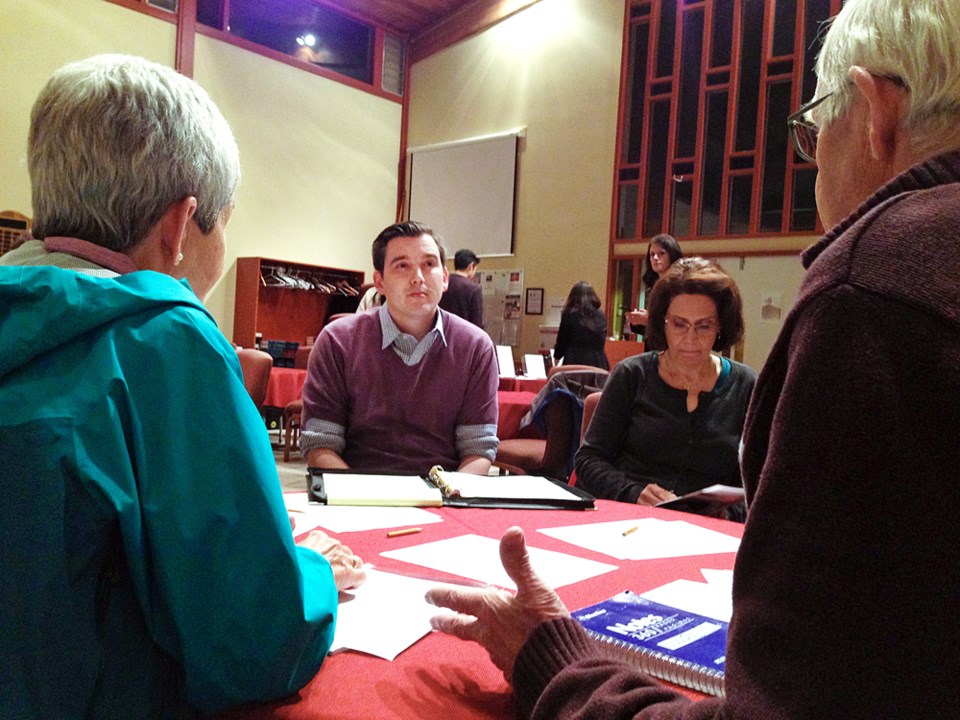About 20 people gathered at Brentwood Presbyterian Church Thursday evening to take part in a town hall meeting on electoral reform.
Hosted by Terry Beech, MP for Burnaby North-Seymour, the two-hour session explored the pros and cons of four electoral systems – first-past-the-post, alternative vote, mixed-member proportional representation and single transferable vote.
Canada and its provinces, including B.C., currently use first-past-the-post. In this system, voters choose one candidate and it’s the candidate with the most votes who wins the seat. The party with the most votes forms government, and could be a majority government or a minority government, depending on how many seats are won.
At the town hall, folks discussed switching from the current system, which they believe doesn’t fully represent them, to one they think is more proportional. Among those gathered was 92-year-old Elsie Dean, who is in favour of single transferable vote.
“I like the idea that more parties are represented in Parliament, because I think you’ll get a more varied discussion, so people will begin to pay more attention to what’s going on in government,” she said.
Alexander Boyd agreed with Dean, arguing single transferable vote would remove strategic voting.
“I think it might be a bit difficult to transition. The first few elections might be weird, but in any countries where there have been minorities for a while, it settles out and the results you get, once the culture of politics changes, tends to produce very good policy and produces governments that cooperate,” he told the NOW in an interview.
Other issues raised during the discussions included how the government would educate the public about the new system if first-past-the-post was replaced; whether a referendum is needed to choose a new system; and if there is a way to “check in” after a few elections to see if the new system was working.
Beech said he found that to be a good takeaway.
“There are certainly going to be consequences with any change. We need to decide as a country whether or not those unintended consequences are worth the benefits,” he said.
During the last federal election, Prime Minister Justin Trudeau promised 2015 was the last time Canadians would cast a ballot under first-past-the-post. In June, an all-party parliamentary committee was struck to gather input on electoral reform. Those meetings wrap up in Ottawa on Oct. 26 and then the committee must submit a report and a list of recommendations to the House of Commons by Dec. 1. Feedback gathered at Thursday’s town hall will be submitted to Maryam Monsef, minister of democratic institutions. MPs had until Oct. 14 to submit constituents’ concerns, while the deadline for the general public was Oct. 7.
Beech said he's "very optimistic" Trudeau will follow through on his campaign promise.
Electoral systems in a nutshell
First-past-the-post: Under FPTP, an elector casts a single vote for a candidate to represent the electoral district in which the voter resides. The winning candidate must gain a plurality of votes to be elected.
Alternative vote: On the ballot, voters rank the candidates running in their riding in order of their preference. To be elected, a candidate must receive a majority of eligible votes cast. Should no candidate get a majority on the first count, the candidate with the fewest votes is dropped and the second preferences on those ballots are redistributed to the remaining candidates. This process continues until one candidate receives the necessary majority.
Mixed-member proportional: The system operates in the same way as mixed-member majority, except a citizen’s second vote, which allocates seats to political parties according to a ranked list drawn up by each party, attempts to compensate for any disproportionate results in the FPTP constituency elections. Additional seats are awarded to qualifying political parties where the number of constituency seats won by a political party fails to reflect overall voter support.
Single transferable vote: Citizens in multi-member ridings rank candidates on the ballot. They may rank as few or as many candidates as they wish. Winners are declared by first determining the total number of valid votes cast, and establishing a vote quota (or a minimum number of votes garnered); candidates must meet or exceed the quota in order to be elected. Candidates who receive the number of first-preference votes needed to satisfy the quota are elected. Any remaining votes for these candidates (that is, first-preference votes in excess of the quota) are redistributed to the second choices on those ballots. Once these votes are redistributed, if there are still seats available after the second count, the candidate with the fewest first-preference votes is dropped and the second-preference votes for that candidate are redistributed. This process continues until enough candidates achieve the quota to fill all available seats.
-Source: www.canada.ca



